Assessing one full year of Bolt EV driving
Posted by Wesley on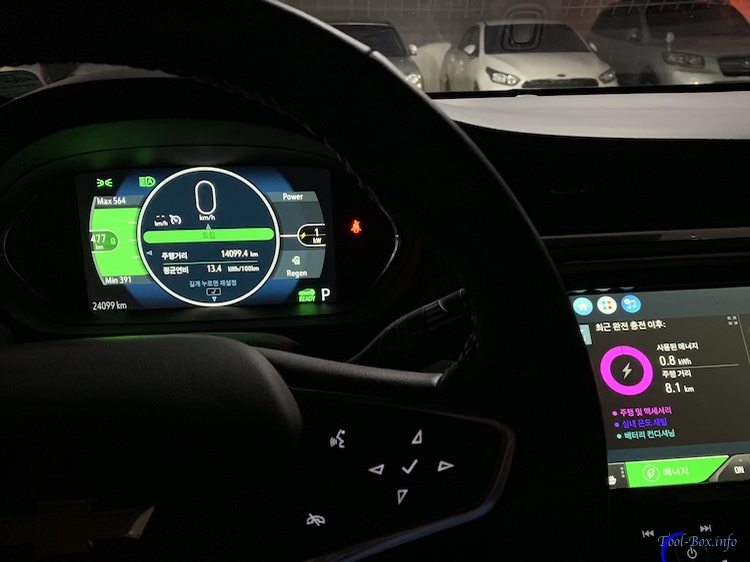
My Bolt EV has travelled 24,099.4km in its first year
On June 1, 2019, my Bolt EV had its first birthday. As it moved around more than 24,000 kilometers, I kept a detailed log to make continuous analysis of the car's conditions and characteristics. Many people including myself are interested in how an electric vehicle fares over the years, so this should provide some good insights.
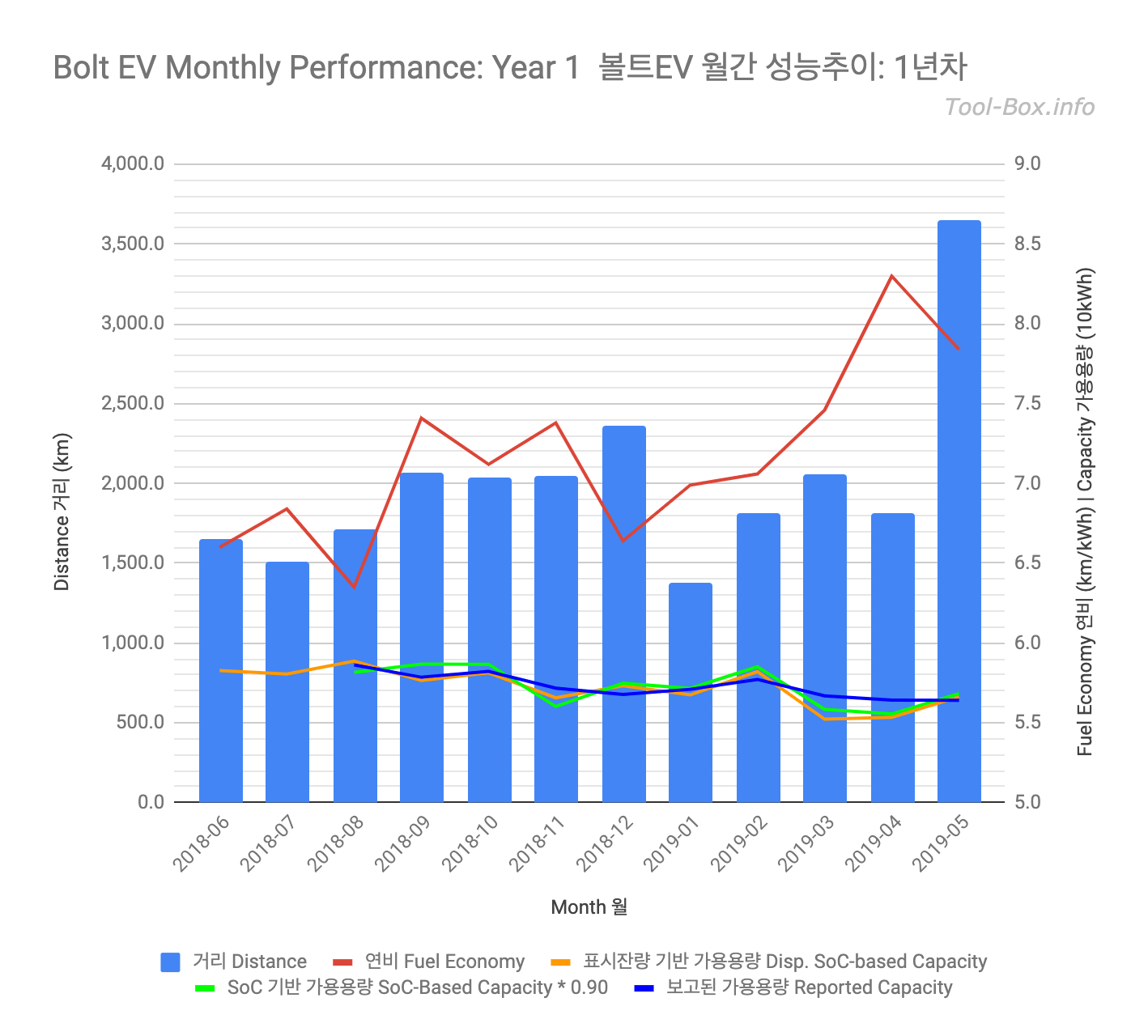
Bolt EV's monthly statistics from June 2018 to May 2019 - distance, fuel economy, and battery capacity
I used to drive around 1,000km per month on average before getting a Bolt EV. But you can see that it has doubled since. Cheaper fuel costs was a major factor (less than 1/10 that of gasoline), with some "new car curiosity" thrown in. Efficiency suffered in summer and winter due to the extreme temperatures, which affects battery performance and climate control use. Largely speaking though, fuel economy had been improving because I've been adjusting my driving style to be smoother in order to go further before recharging. This proved to be helpful in long-distance trips.
The three lines at the bottom of the graph depict the battery capacity as calculated by various means. The battery degradation is a major concern for many, so I kept track of this closely as well. Going by the reported values, my Bolt EV originally had 58.63kWh of usable capacity (65.14kWh raw) and had 55.98kWh usable (62.20kWh raw) by 24,099.4km. This is a degradation of 4.52%. Assuming linear progression, the battery would have exactly 70.0% of capacity left after 160,000km. This is in line with the industrial average warranty and shows that my Bolt EV's battery is in a reasonably good condition so far.
So why did I have three lines here? It stems from the fact that the Bolt EV doesn't tell you its battery health outright. One of the Parameter ID (PID) readings from the OBD-II port (#2241A3) correlates directly with battery capacity, but interpreting the number has been up for debate. So I decided to find an interpretation that I was comfortable with.
In order to infer what the car thinks of the battery capacity, I need to see how much the battery charge drops after a certain amount of power use. The car's dashboard shows the battery's State of Charge ("Displayed SoC") in 5% steps. MyChevrolet app and OBD-II PID #228334 are more accurate - 1% and 0.4% steps, respectively. Meanwhile, the infotainment screen displays the energy spending in 0.1kWh steps. Putting these two together, you get the orange "Disp. SoC-based Capacity" line. If you use the raw SoC data from OBD-II PID #015B instead and multiply the result by 0.9, you get the green "SoC-Based Capacity" line that nearly matches the orange line. So why the 0.9 multiplier?
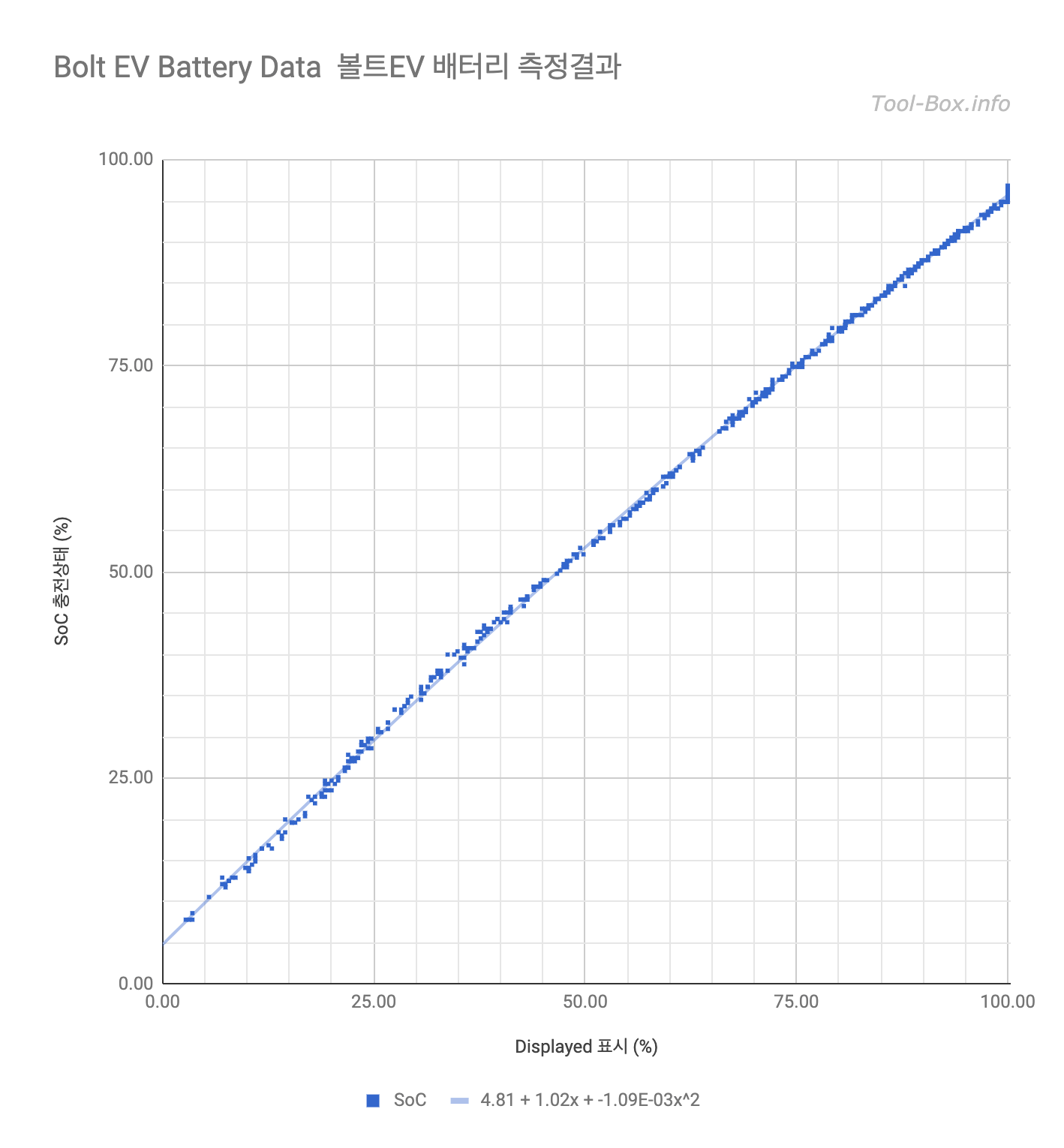
It's because the displayed SoC does not span the full capacity of the battery to avoid stressing and shortening the lifecycle. This graph shows the relation between the two numbers from the logs. Although GM may have originally planned for a 4% overhead at the each end, my data actually shows this to be close to 5%. That is, displayed SoC of 0% and 100% equate to raw SoC of 5% and 95%, respectively. Since the raw SoC only spans 90% of the displayed value, you need the 0.9 multiplier to align the two lines.
(What's the small uptick at the 100% displayed SoC? When a slow L2 charger is used, the car keeps charging after hitting 100% displayed SoC and stops at around 96% to 96.5% raw SoC. This way, you can eke out a bit more drivable range.)
Now, the PID #2241A3 in question looked suspiciously close to the electric charge of the battery in 0.1Ah steps (e.g. 1,751). For comparison, the official value as reported to the Korean Ministry of Environment is 174Ah. Nominal voltage of a lithium polymer battery is 3.7V and there are 96 packs in series, so the resulting voltage comes to 355.2V.
1,751Ah x 355.2V = 621,955.2Wh ~= 62.20kWh
This would be the raw capacity for the value of 1,751, and the usable capacity would again be multiplied by 0.9, resulting in 55.98kWh. Data derived from this calculation shows up as the blue line, or "Reported Capacity". You'll see that this fits the orange and green lines pretty well, but in a steadier manner. So this is my interpretation of the battery capacity data from the OBD-II PID.
PID #2241A3 x 0.03552 = Raw Capacity
Raw Capacity x 0.9 = Usable Capacity
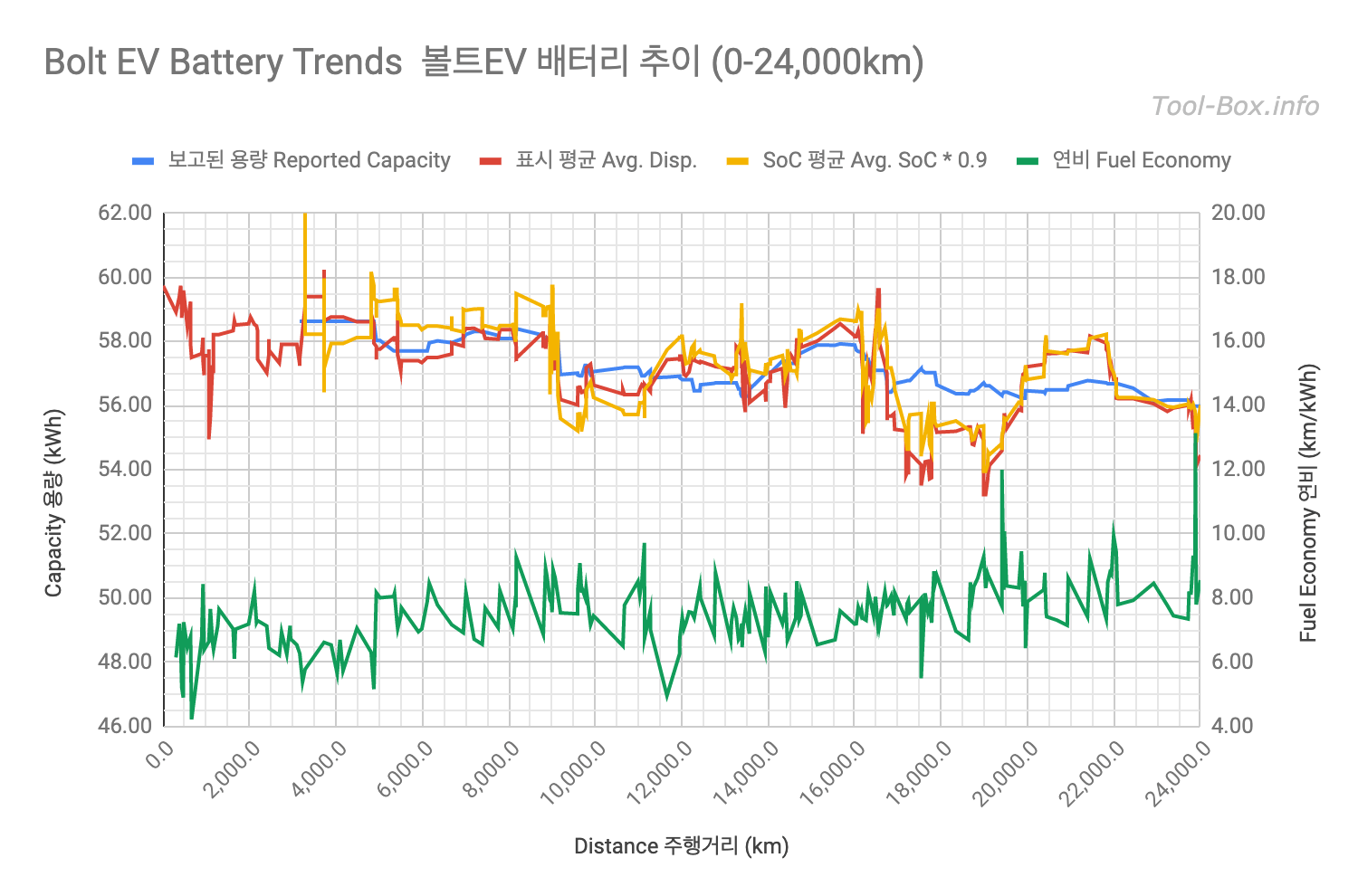
Let's look at the fuel economy and battery capacity numbers by the distance. You can see some dips happening around 5,000km and 11,000km marks for the fuel economy values due to driving in very hot and cold temperatures. But overall the fuel economy has improved steadily.
As for the battery capacity, the three lines are close to each other until there's a relatively big swing between the 17,000km and 22,000km marks. During this period, which was roughly around March to April 2019, the blue line (reported capacity) remained relatively steady and the other two lines eventually reunite after.
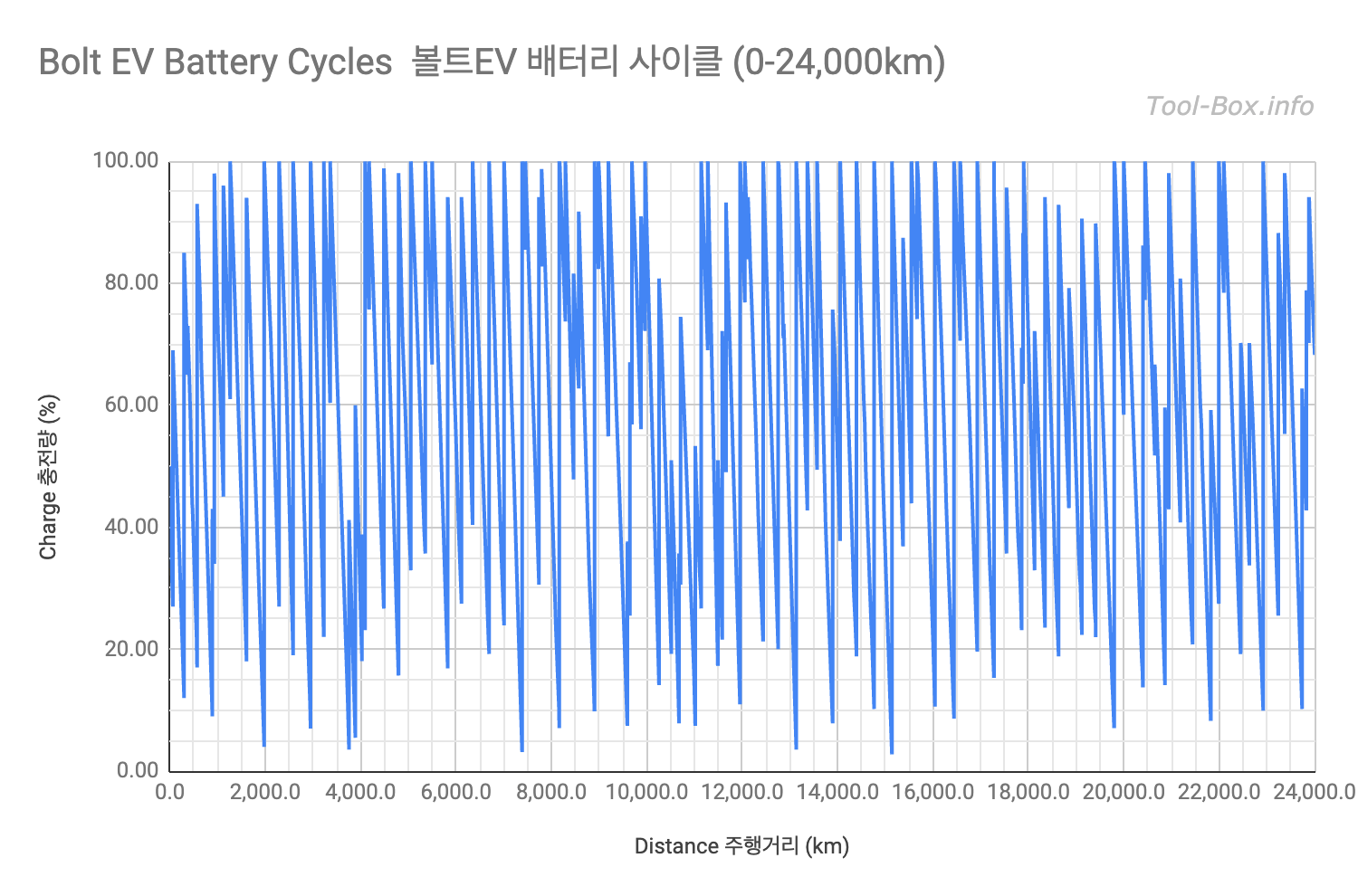
Some may ask if my charging were normal enough to get this result. I would like to think so, as illustrated by this graph. I generally try to charge up to 100% unless I'm in the middle of a long distance trip, and I use a mix of DCFC (fast DC, 50 to 100kW) and L2 (slow AC, 7kW) chargers as they are available to me. I also try to charge before dropping below 20%, but in many times it did drop to 10% range.
So there you have it. My Bolt EV is healthy and I've been getting more efficient at driving it. It's a solid electric vehicle that has suited my 4-member family quite well over many trips long and short. I hope it lasts a very long time.

Bolt EV battery percentage - displayed vs. SoC values
It's because the displayed SoC does not span the full capacity of the battery to avoid stressing and shortening the lifecycle. This graph shows the relation between the two numbers from the logs. Although GM may have originally planned for a 4% overhead at the each end, my data actually shows this to be close to 5%. That is, displayed SoC of 0% and 100% equate to raw SoC of 5% and 95%, respectively. Since the raw SoC only spans 90% of the displayed value, you need the 0.9 multiplier to align the two lines.
(What's the small uptick at the 100% displayed SoC? When a slow L2 charger is used, the car keeps charging after hitting 100% displayed SoC and stops at around 96% to 96.5% raw SoC. This way, you can eke out a bit more drivable range.)
Now, the PID #2241A3 in question looked suspiciously close to the electric charge of the battery in 0.1Ah steps (e.g. 1,751). For comparison, the official value as reported to the Korean Ministry of Environment is 174Ah. Nominal voltage of a lithium polymer battery is 3.7V and there are 96 packs in series, so the resulting voltage comes to 355.2V.
1,751Ah x 355.2V = 621,955.2Wh ~= 62.20kWh
This would be the raw capacity for the value of 1,751, and the usable capacity would again be multiplied by 0.9, resulting in 55.98kWh. Data derived from this calculation shows up as the blue line, or "Reported Capacity". You'll see that this fits the orange and green lines pretty well, but in a steadier manner. So this is my interpretation of the battery capacity data from the OBD-II PID.
PID #2241A3 x 0.03552 = Raw Capacity
Raw Capacity x 0.9 = Usable Capacity

Bolt EV fuel economy and battery capacity by the distance - numbers derived from displayed & SoC values, and actual reported values
Let's look at the fuel economy and battery capacity numbers by the distance. You can see some dips happening around 5,000km and 11,000km marks for the fuel economy values due to driving in very hot and cold temperatures. But overall the fuel economy has improved steadily.
As for the battery capacity, the three lines are close to each other until there's a relatively big swing between the 17,000km and 22,000km marks. During this period, which was roughly around March to April 2019, the blue line (reported capacity) remained relatively steady and the other two lines eventually reunite after.

Bolt EV charging & discharging cycles spanning 24,000km
Some may ask if my charging were normal enough to get this result. I would like to think so, as illustrated by this graph. I generally try to charge up to 100% unless I'm in the middle of a long distance trip, and I use a mix of DCFC (fast DC, 50 to 100kW) and L2 (slow AC, 7kW) chargers as they are available to me. I also try to charge before dropping below 20%, but in many times it did drop to 10% range.
So there you have it. My Bolt EV is healthy and I've been getting more efficient at driving it. It's a solid electric vehicle that has suited my 4-member family quite well over many trips long and short. I hope it lasts a very long time.